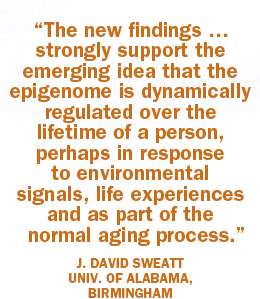Ch-ch-ch-changes
Dynamic throughout life, epigenetic shifts also appear to run in families
- More than 2 years ago
If you find yourself becoming more like your parents, don’t blame it just on your genes. Epigenetics may be responsible too.

Epigenetics refers to changes to DNA that don’t alter the genes themselves but nudge their level of activity up or down, much like a thermostat controls heating or cooling. Controlling gene activity is important for guiding development and maintaining health.
A team of scientists reports in the June 25 Journal of the American Medical Association that one form of epigenetic modification, called DNA methylation, changes throughout an individual’s life and that families tend to have similar patterns of change.
“This is a fascinating study that convincingly demonstrates that epigenetic DNA marks change within an individual over time,” says J. David Sweatt, director of the McKnight Brain Institute at the University of Alabama, Birmingham. Sweatt was not involved in the current study. “These are fascinating findings because the standard model for epigenetics has been that DNA marks are immutable once set down as part of development. The new findings … strongly support the emerging idea that the epigenome is dynamically regulated over the lifetime of a person, perhaps in response to environmental signals, life experiences and as part of the normal aging process.”
Such changes have been proposed to contribute to diseases such as cancer and other disorders that don’t appear until late life, but, before now, there was little evidence to show that epigenetic settings change as a person ages, says Andrew Feinberg, director of the Center for Epigenetics at JohnsHopkinsUniversity in Baltimore, and an author of the new study.
Feinberg and his colleagues examined DNA methylation in 111 people from Iceland who are part of a study on aging and in 126 people from Utah who are part of a genetic study of families. Study participants contributed two DNA samples each, collected at different times during their lives. The Icelandic samples were taken on average 11 years apart, and the Utah families had about 16 years between sample collections.
Some of the people increased overall methylation of their genes as they aged. Others reduced methylation. The number of people who increased methylation was about the same as the number of people who decreased methylation, Feinberg says. That could account for why an earlier study that averaged methylation levels in groups of people instead of following individuals over time failed to find epigenetic changes associated with aging.
Even though the researchers expected to find epigenetic changes, they were surprised that methylation among family members tended to move in the same direction, Feinberg says. The researchers don’t yet know whether these patterns are because of genetic determinants, environmental influences or a combination of both.







